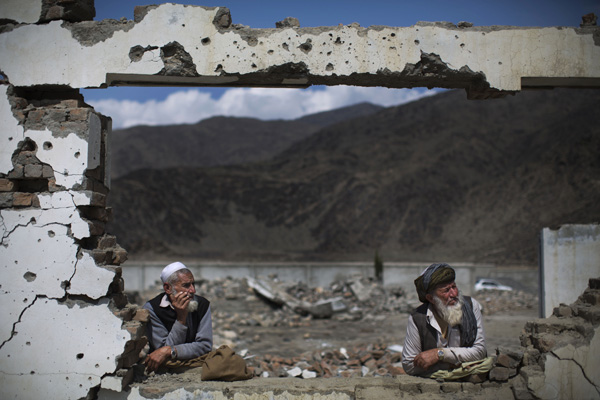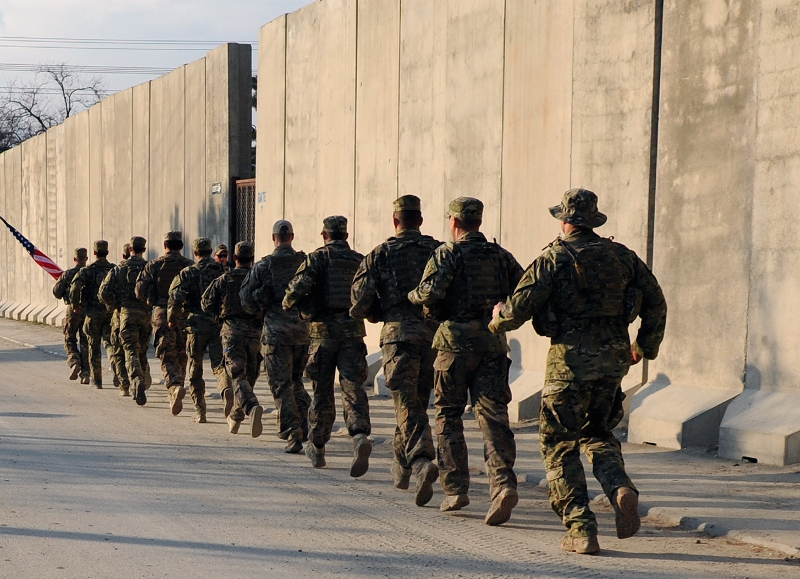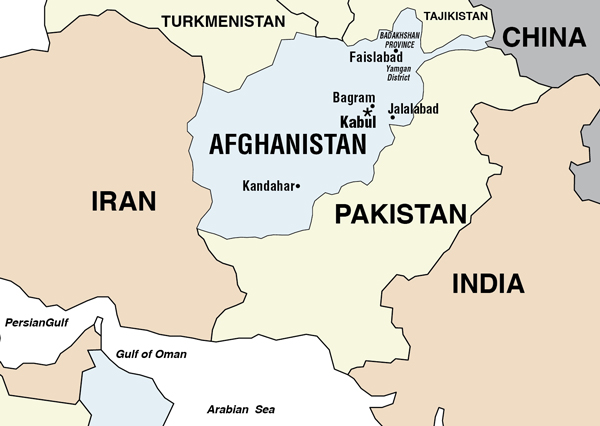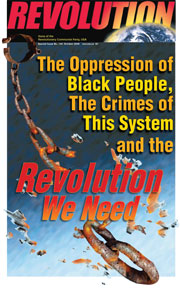From A World to Win News Service:
Afghanistan: The Occupation Continues and the War is Intensifying
July 27, 2015 | Revolution Newspaper | revcom.us

Two men look out of frame of a village school destroyed by U.S. airstrike in Nangarhar province, Afghanistan, 2013. (AP photo)
July 20, 2015. A World to Win News Service. At the moment every aspect of life of the people in Afghanistan is marked by the war and its development. So it is important to concentrate on the state of the war and the way the occupation is continuing to intensify it.
There have been major changes over the last year. On one side, despite or because of 14 years of occupation, there has been a broadening of the spectrum of Taliban operations. On the other, after a presidential election that led to accusations of fraud and finally a power-sharing compromise between two main candidates, the Afghani government has signed strategic agreements with the U.S. and NATO that also step up the war, both by keeping foreign troops in the country beyond the promised date for their withdrawal and by an increased role for Afghani troops under U.S. and European direction. Afghanistan has also witnessed the emergence on its soil of the Islamic fundamentalist Daesh (also called ISIS or ISIL), a rival to the Taliban.
The Bilateral Strategic Agreement
Ashraf Ghani, the new president of Afghanistan, signed the long-awaited bilateral strategic agreement between the U.S. and Afghanistan a short time after he came to office. It allows U.S. forces to stay beyond 2014, when they had initially promised to leave, and for as long as an additional decade.
The agreement also renews the legal immunity for U.S. troops that puts them beyond the reach of any present or future Afghani law. No U.S. soldier can be arrested or put on trial by Afghans, even for the most horrendous crimes, whether the many authorized massacres from the air and on the ground, or unauthorized killings such as the murder of the ten children and six adults by an American soldier in a Kandahar village in March 2012.
"Under the Bilateral Security Agreement's annexes the U.S. military will have access to nine major land and airbases, to include the massive airfields at Bagram, Jalalabad and Kandahar, staging areas not only for air operations in Afghanistan but the U.S. drone strikes that continue across the border in tribal Pakistan," wrote the Guardian, September 30, 2014.
This agreement gives present and future U.S. presidents the authority to increase the number of American forces to any level they might want. As described in the same Guardian article, the accord's terms "acknowledge that U.S. military operations to defeat al-Qaeda and its affiliates may be appropriate in the common fight against terrorism." In plain language, contrary to President Barack Obama's pledge, U.S. troops are continuing to wage combat operations in Afghanistan, and the current draw-down of their forces can be reversed if the U.S. deems it necessary.

U.S. occupying army in Afghanistan. (Photo: U.S. Air Force)
The occupiers are trying to give people in their own countries and all over the world the impression that the war in Afghanistan is coming to an end because they have fulfilled their aims.
Neither aspect is true. The war is not coming to an end and they are planning to stay in Afghanistan for a long time. What could be different is that this war may be more fully fought at the expense of Afghani lives on both sides, significantly reducing U.S. financial expenditures that have risen to $1 trillion so far.
After drawing down some forces in December 2014, the U.S. still has around 11,000 soldiers in Afghanistan and a similar number of mercenaries (euphemistically called "private security contractors"), without counting armed and unarmed civilian employees. The U.S. intends to use its Special Forces and advisers to lead Afghani troops, while continuing to take part in some combat operations where they can use best use their technology. The U.S. had initially scheduled a reduction of its forces to 5,500 by the end of 2015, but the new Defense Secretary Ashton Carter later announced that this pace will be slowed down, presumably to enable the U.S. to continue the combat operations that it had promised to end last year.
The war will continue and its nature remains the same, but more Afghan soldiers—the army of 350,000 that they have trained—are now supposed to fight and die for U.S. global interests. In 2014 alone, 5,000 Afghanistan government security forces were killed, compared with the 3,500 U.S. and NATO troops killed since the beginning of the war.
At the onset of their invasion of Afghanistan, the imperialists justified it by claiming it would be a big blow against armed Islamism on a world scale, that it would annihilate fundamentalism in Afghanistan, build a strong government based on "democratic" values, liberate women from backward and fundamentalist forces, and finally bring peace, security, stability and prosperity for the people of Afghanistan. We can see none of these things after 14 years of war and occupation, and they have never been the war's purpose.
Speaking of his troop reduction, Obama said "that the international effort in Afghanistan had devastated al-Qaeda's core leadership, brought justice to Osama bin Laden and disrupted terrorist plots. He said U.S. troops and diplomats had helped Afghans reclaim their communities and move toward democracy." (Associated Press, December 28, 2014)
First of all, this statement about "devastating al-Qaeda's leadership" is not true. The network is bigger and more powerful than ever, with bases and influence in many countries with a substantial Sunni Islamic population in the Middle East, Asia and Africa. In fact the biggest danger to Al-Qaeda is neither the U.S. nor the Afghani government army but its Islamist competitor Daesh.
If Obama is referring to the killing of Osama bin Laden as a success achieved through his war in Afghanistan, the truth is that it had nearly nothing to do with the U.S. occupation. There have been many media reports, which while unverified strike serious observers as plausible, that he was hidden by Pakistan authorities, given a safe house by the ISI (the Pakistani secret service) near a military garrison where he could be protected. And even if the U.S. was not aware of his hideout from the beginning, this was an issue between the U.S. and its "special ally" in the region and not necessarily related to the course of the Afghanistan war.
The occupation has not "helped Afghans reclaim their communities and move toward democracy." Instead it plunged the country deeper into war and destroyed the lives of hundreds of thousands of people. According to the study by the Costs of Wars Project supervised by Nuta Crawford, a professor of political science at Boston University, "The wars in Afghanistan and Pakistan have left nearly 150,000 soldiers and civilians dead... Another 162,000 have been wounded since the U.S.-led offensive that toppled the Taliban." (Agence France-Presse, June 3, 2015)
The same study also indicates that these wars have also caused even more indirect deaths, as people are killed by malnutrition, the lack of health care and the hardships of war and displacement. It estimates that for every death due to direct effects of war, "bullets, bombs, fire and so on... three to 15 die indirectly."
The State of the War

The horrific crimes and constant abuses committed by the occupiers through their continuous stop-and-search operations, night raids on village compounds, bombardment of civilians and other random killings all supposedly targeting the Taliban, seem to have made it stronger and deadlier than ever. The Taliban have increasingly demonstrated their ability to pass through the tight security measures imposed on protected areas and buildings in Kabul and penetrate into the heart of government institutions. Their assault on the Afghanistan Parliament building in June, sending officials and parliamentarians scurrying, was an embarrassment to the security forces, the government and the occupiers.
In another military operation, the Taliban captured Yamgan district in the province of Badakhshan in the country's North-East. More than 300 Taliban fighters started an attack in the early morning on June 6 and seized the district center before noon. Shah Walliualah Adeeb, the governor of Badakhshan, "confirmed the fall of the district and admitted that the government security forces had retreated half a mile from the administrative center." (New York Times, June 6, 2015)
Ten days later, the Taliban were still in control of the Yamgan district; however hundreds of families had left their homes looking for a safer place to stay. Many were left hungry, since the road to the provincial capital Faislabad was blocked and food prices increased up to eight times as much as before. Some people were eating wild weeds for survival, the governor told BBC. (June 15, 2015)
Yamgan is not the only district that the Taliban has seized or attacked in recent months, but its seizure was particularly important because they had never before been able to operate in the province, even when they held nationwide political power in the 1990s. Badakhshan is populated mainly by people of the Tajik ethnicity. It was the stronghold of the main group of jihadi rivals to the Taliban, the Northern Alliance led by Ahmad Shah Massoud, the Tajik commander assassinated by Al-Qaeda just before September 11, 2001.
Badakhshan is in a mountainous region and from a military point of view has some strategic importance as Afghanistan's gateway to Central Asia (Tajikistan) and China, where the Taliban are eager to expand. Although Yamgan is situated in the southern part of Badakhshan, a long way from its northern reaches, getting this far represents an important step for the Taliban.
Taliban offensive units nowadays are increasingly bigger, consisting of a few hundred men rather than a few dozen. At the same time they have become capable of accessing and attacking different and wider areas, far beyond the Pashtun regions that were their area of maneuver in the initial years of the war. It is reported that the Taliban carried out 6,600 attacks between May and October 2014.
As the war escalates, it takes a greater number of victims. According to figures released by the United Nations on December 20, 2014, ten thousand civilians were killed and wounded in 2014, a 20 per cent increase compared with previous years. More civilian casualties and more Taliban: this is the result of the 14 years of occupation, even after the "surge" of more than 150,000 U.S. and NATO troops in 2011.
The Question of Negotiations
Recently the Taliban leader Mullah Omar reportedly made a rare public statement confirming that his organization has begun negotiations with the U.S.-imposed Afghani government. Pakistani authorities are said to have mediated two meetings, one in Ürümqi in China and the other near Islamabad in Pakistan. Talk about such gatherings has been going on for years. Even if now the two sides are serious, that does not mean that they are close to an agreement. And if they were, that would not necessarily mean the end of the war in Afghanistan.
Afghanistan's strategic location at the crossroads of Central Asia, South Asia and the Middle East has led to continuous contention for control of the country. Afghanistan cannot remain unaffected by the continuing rise of Islamic fundamentalism and new Islamist forces like Daesh in the region. The wars now engulfing Syria, Iraq, Libya and Yemen reflect increased and intensified imperialist intervention in the region, and increased and intensified rivalry between regional powers such as Israel, Saudi Arabia, Turkey and Iran in the Middle East and Pakistan and India in South Asia. Afghanistan is woven with many strings into the contradictions in the region and consequently the world.
The first step to ending Afghanistan's misery is to put an end to the occupation, which means getting rid of foreign combat forces and the political and military advisers and apparatuses used by the imperialists and reactionary regional powers playing their atrocious games in Afghanistan and the region.
It is hard to imagine that these forces will leave this country of their own will. They need to be kicked out or forced out by a real revolutionary movement of the masses that should be built as quickly as possible. The Taliban, Daesh and other Islamic forces currently in opposition to the government are part of the problem and can never be part of a solution.
A World to Win News Service is put out by A World to Win magazine, a political and theoretical review inspired by the formation of the Revolutionary Internationalist Movement, the embryonic center of the world's Marxist-Leninist-Maoist parties and organizations.
Volunteers Needed... for revcom.us and Revolution
If you like this article, subscribe, donate to and sustain Revolution newspaper.







